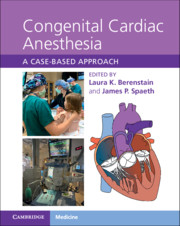Book contents
- Congenital Cardiac Anesthesia
- Congenital Cardiac Anesthesia
- Copyright page
- Dedication
- Contents
- Contributors
- Introduction
- Chapter 1 A Congenital Heart Disease Primer
- Section 1 Left-to-Right Shunts
- Section 2 Right-Sided Obstructive Lesions
- Section 3 Left-Sided Obstructive Lesions
- Section 4 Complex Mixing Lesions
- Section 5 Single-Ventricle Physiology
- Section 6 Heart Failure, Mechanical Circulatory Support, and Transplantation
- Section 7 Miscellaneous Lesions and Syndromes
- Index
- References
Chapter 1 - A Congenital Heart Disease Primer
Published online by Cambridge University Press: 09 September 2021
- Congenital Cardiac Anesthesia
- Congenital Cardiac Anesthesia
- Copyright page
- Dedication
- Contents
- Contributors
- Introduction
- Chapter 1 A Congenital Heart Disease Primer
- Section 1 Left-to-Right Shunts
- Section 2 Right-Sided Obstructive Lesions
- Section 3 Left-Sided Obstructive Lesions
- Section 4 Complex Mixing Lesions
- Section 5 Single-Ventricle Physiology
- Section 6 Heart Failure, Mechanical Circulatory Support, and Transplantation
- Section 7 Miscellaneous Lesions and Syndromes
- Index
- References
Summary
The ability to interpret cardiac data to determine an individual patient’s cardiac anatomy and physiology is paramount in developing a safe plan for anesthesia or sedation. Although cardiac lesions can be placed into broad diagnostic categories, within each category and for each lesion significant variation can exist. For example, infants with tetralogy of Fallot (TOF) may have obstruction to pulmonary blood flow ranging from minimal to severe; if obstruction is minimal, they may exhibit signs and symptoms of pulmonary overcirculation or if severe, they may be overtly cyanotic. Patients who have been described as “pink tets” at home may, during the stress imposed by anesthesia and surgical manipulation, exhibit significant tet spells. Wide pathophysiologic variability exists even within a given lesion and each patient must be considered on an individual basis, rather than being defined by his or her diagnosis. Patients who have undergone corrective surgeries, although “repaired,” often have important residua or sequelae that must be noted.
- Type
- Chapter
- Information
- Congenital Cardiac AnesthesiaA Case-based Approach, pp. 2 - 8Publisher: Cambridge University PressPrint publication year: 2021



